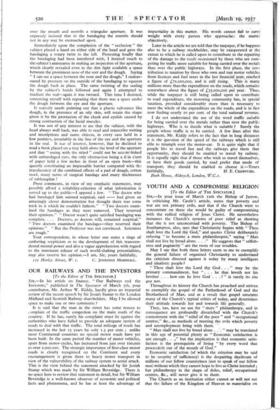`! SEEING WITH THE MIND"
[To the Editor of THE SPECTATOR.] Sul,—Some twenty months ago I, with other medical men, a physicist, and numerous Press representatives, was invited to " investigate " the phenomenon referred to. The technique of occlusion was, by express direction of the subject, exactly as your correspondent describes. After the " mind-seer " had retired for a brief while behind -a screen, I first placed over the eyes two large pads of dough ; the skin had an oily feel, the dough did not adhere to it. Next came pads of cotton wool, held in place by an ordinary surgical bandacg disposed in a circular fashion around the head. The sealing was completed by three articles of table linen, termed " soviets," two obliquely on either side of the head and face, the other horizontally around the lower jaw and neck—thus leaving
over the mouth and nostrils a triangular aperture. It was expressly insisted that in the bandaging the nostrils should not in any way be encroached upon.
Immediately upon the completion of the " occlusion " the subject placed a hand on either side of the head• and give the bandaging a rotary twist to the left. Protesting loudly that the bandaging had been interfered with, I insisted much to the subject's annoyance in making an inspection of the aperture, which clearly revealed even in the dim light available a space between the prominent nose of the seer and the dough. Saying "I can see a space between the nose and the dough," I endeav- oured by pressure on the outside of the bandaging to squeeze the dough back in place. The same twisting of the sealing by the subject's hands followed and again I attempted to readjust the seal—again it was twisted. This time I desisted, contenting myself with repeating that there was a space under the dough between the eye and the aperture.
It scarcely needs pointing out that a plastic substance like dough, in the presence of an oily skin, will retain the shape given it by the protrusion of the cheek and eyelids caused by strong contraction of the facial muscles.
It was not of any interest to me that the subject, with the head always well back, was able to read and transcribe writing and inscriptions and name objects, in every case held in a low position, invariably in the line of the eye and the aperture in the seal. It was of interest, however, that he declined to read a book placed on a tray held above the level of the aperture and that "seeing with the mind" could not be acccm7lished with unbandaged eyes, the only obstruction being a tf in sheet of paper held a few inches in front of an open book—this queerly constituting an impassable barrier compared with th?.. translucency of the combined effects of a pad of dough, cotton wool, many turns of surgical bandage and many thicknesses of tablenapkin !
Press comments, in view of my emphatic statements, may possibly afford a reliability-criterion of what information is served up to the public—I append a few. "The doctor who had bandaged him seemed sceptical, said — had given an amazingly clever demonstration but thought there was some trick in it which he couldn't fathom." "Two doctors exam- ined the bandages as they were removed. They reserved their opinions." "Doctor wasn't quite satisfied bandaging was complete. . . . Doctors, as doctors will, remained sceptical." "Two doctors examined the bandages—they reserved their opinions." "But the Professor was not convinced. Scientists are tough."
Your correspondent, in whose letter one notes a tinge of cankering scepticism as to the development of this transcen- dental mental power and also a vague apprehension with regard to the imminent release of such world-shaking potentialities, may also reserve his opinion.—! am, Sir, yours faithfully,





































































 Previous page
Previous page